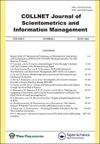Novel model for predicting the future volume of research articles on applications of Quantum Dots
IF 0.8
Q2 INFORMATION SCIENCE & LIBRARY SCIENCE
COLLNET Journal of Scientometrics and Information Management
Pub Date : 2022-01-02
DOI:10.1080/09737766.2022.2063091
引用次数: 0
Abstract
The paper aims to briefly introduce to the topic of quantum heterostructures taking Quantum Dots (QD) as the topic of interest. It reviews different mathematical models explaining the behaviour of QD, and it proposes a novel method to predict the future article volumes on the topic of applications of QD. The paper also reviews the use of QD in quantum computing. The paper opted for a numerical approach to predict future article volumes. Firstly, bibliometric data for the past 40 years is collected and then by assuming a relationship between relevant variables, a governing equation is developed which is then solved using the Finite Difference Method (FDM). The paper provides insights into how a prediction model can be developed without using tons of metrics. It also suggests that a prediction model can be developed using only the past behaviour of the concerned dataset. Due to the chosen research approach, the effectiveness of the model may be less. Therefore, researchers are encouraged to test the proposed method further. The paper includes the practical implications of an easily analysed and executable model. The paper also shows that the model proposed can not only be used to predict future article volumes but also to predict datasets that exhibit a quasi-linear nature. This paper fulfils the need for a new, easier prediction method.预测量子点应用研究文章未来数量的新模型
本文以量子点(QD)为研究对象,简要介绍了量子异质结构。它回顾了解释量子点行为的不同数学模型,并提出了一种新的方法来预测关于量子点应用主题的未来文章量。本文还回顾了量子点在量子计算中的应用。论文选择了数值方法来预测未来的文章量。首先,收集了近40年的文献计量数据,然后通过假设相关变量之间的关系,建立了一个控制方程,然后使用有限差分法(FDM)求解。本文提供了如何在不使用大量指标的情况下开发预测模型的见解。它还表明,仅使用相关数据集的过去行为就可以开发预测模型。由于所选择的研究方法,模型的有效性可能会降低。因此,鼓励研究人员进一步测试所提出的方法。本文包含了一个易于分析和可执行的模型的实际含义。本文还表明,所提出的模型不仅可以用于预测未来的文章量,还可以用于预测具有准线性性质的数据集。本文满足了一种新的、更简单的预测方法的需要。
本文章由计算机程序翻译,如有差异,请以英文原文为准。
求助全文
约1分钟内获得全文
求助全文
来源期刊

COLLNET Journal of Scientometrics and Information Management
INFORMATION SCIENCE & LIBRARY SCIENCE-
自引率
0.00%
发文量
11
 求助内容:
求助内容: 应助结果提醒方式:
应助结果提醒方式:


